Resources/Child Nutrition Hub/Summer Meals
Feeding kids year round.
Hunger doesn’t take a vacation. Summer meals help fill the gap when school is out and ensure that children come back to school well-nourished and ready to learn. At Summer meal sites, all children 0-18 eat for free–no paperwork, no registration, no I.D. needed! We help communities establish and grow their summer meal programs through individualized support and outreach.
About summer meals:
Summer meals are critical to student success: nourishing students during summer vacation and helping them return to school ready to learn. Tens of thousands of Vermont students rely on school meals, and summer meal programs help combat hunger and learning loss. In addition to supporting student health and wellbeing, participation in summer meals keeps kids connected to their peers and community.
Contact us for customized support to establish or grow summer meals in your community.
We help you:
Navigate the federal nutrition programs that fund summer meals and snacks.
Attract participants through various outreach and marketing best practices.
Connect with enrichment activities and programs, an important part of attracting kids to meal sites.
Overcome barriers to your meal program like location, transportation, and equipment needs.
Why summer meals? +
When school lets out, more than 80,000 Vermont kids lose access to free school breakfast and lunch they receive during the school year. Summer meal programs help fill this gap by providing free meals and snacks to children who might otherwise go hungry. Plus, summer meals are often paired with enrichment activities that keep kids active while they are receiving essential nutrition for their developing brains. Studies show that when children don't get proper nutrition, they fall behind their peers academically when returning to school in the fall.
Learn more about the achievement gap many children from low-income households suffer:
- Every summer, low-income youth lose two to three months in reading while their higher-income peers make slight gains. Most youth lose about two months of math skills in the summer.
- These reading and math losses add up. By fifth grade, summer learning loss can leave low-income students 2 1/2 to 3 years behind their peers.
- Research shows that while gaps in student achievement remain relatively constant during the school year, the gaps widen significantly during the summer.
- Low-income youth lose access to healthy meals over the summer. Nationally, six out of every seven students who receive free- and reduced-price lunches miss out when the school year ends.jhh\
- Summer meals are often the driving factor in children participating in a summer program. When summer meals are available, kids are more likely to participate in programming that can provide additional learning opportunities. With proper nutrition for their developing brain, they can better benefit from the activities and return to school ready to learn.
Source for bullets 1-4: National Summer Learning Association
Summer meals 101 +
Summer is the most vulnerable time for Vermont’s kids, but there are two federal nutrition programs designed to address the summer nutrition gap- the Summer Food Service Program (SFSP) and the Seamless Summer Option (SSO- available to schools only).
Who is involved?
- Sponsors: Any non-profit organization (including schools) may sponsor a summer meal program. Sponsors are responsible for implementing the program at one or more sites and receive reimbursement for meals served at those respective sites. Sponsors enter into an agreement with the state agency to offer summer meals.
- Sites: These are the physical locations where meals are served. Each site has a supervisor who oversees meal service and communicates with the sponsor.
- Vermont Agency of Education Child Nutrition Programs: Administers summer meals for the state of Vermont. AOE offers sponsor trainings each winter/spring and visit with sponsors regularly to support their program compliance.
- Hunger Free Vermont: We’re here to support you! Every year, our staff compile regional summer meal site lists and engage our network of partners around Vermont to spread the word.
Where do summer meals happen?
- Summer meals can happen anywhere kids can eat together, rain or shine! Meal sites in Vermont include libraries, public parks and pools, churches, camps, and schools.
What does a summer meal look like?
- Summer meals follow USDA guidelines. They can be served hot or cold, and because summer is a time of agricultural abundance in Vermont, it’s a great opportunity to integrate local food into these meals.
- Breakfast must include: 1 serving of fruit or vegetable, 1 serving of a grain or bread item, and 1 cup of fluid milk
- Lunch or supper includes: 2 servings of fruit or vegetables, 1 serving of grain or bread, 1 serving of a protein, and 1 cup of fluid milk
Outreach Materials +
We know that getting the word out to children and families in your area is important to ensuring a successful, well-attended summer meal program! Along with our regional site lists, we have other materials and tips available to help you promote summer meal site information to the children and families in your community.
Use our printable outreach materials to raise awareness of summer meals in your town or community:
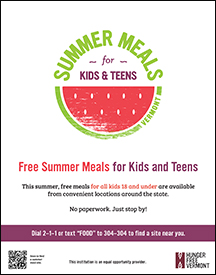
Promotional Poster (11x14)
Fillable Promotional Poster
Hunger Free Vermont has professionally-printed copies available- visit our COVID page to order.
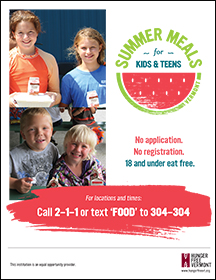
General Flyer(8.5 x 11)
Half Sheet Flyer (8.5 x 5.5)
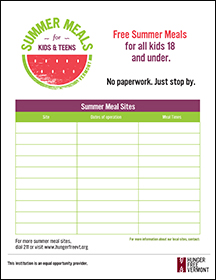
Fillable Meal Site Flyer
Customize this flyer by adding in meal site info for your community!
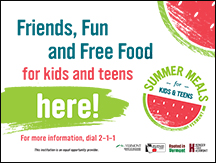
These are available upon request. Please contact our Program Outreach Team.
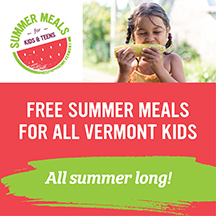
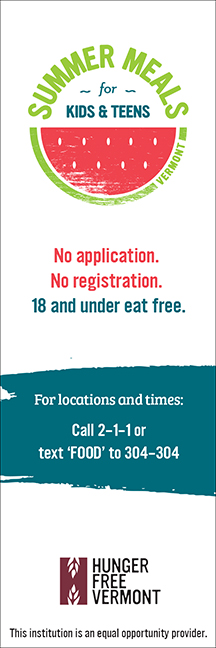
Bookmark
These are available upon request. Please contact our Program Outreach Team.



